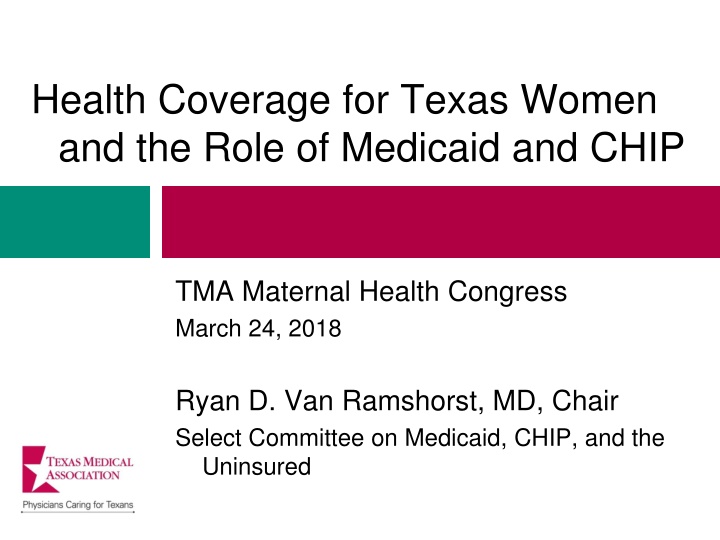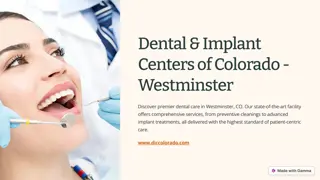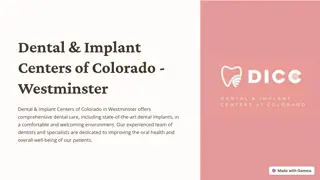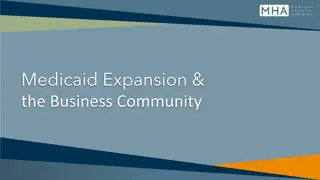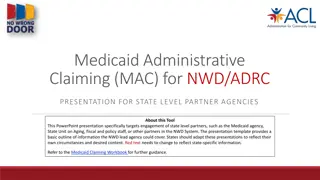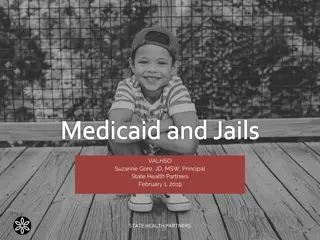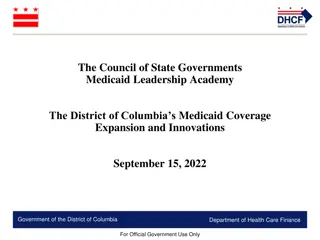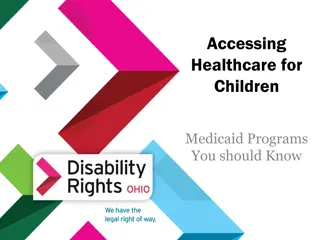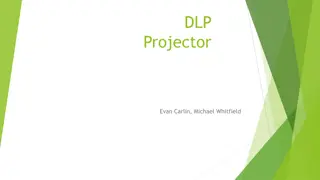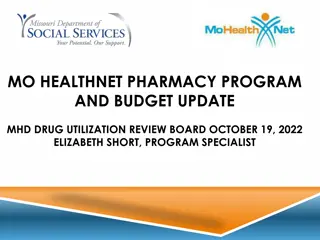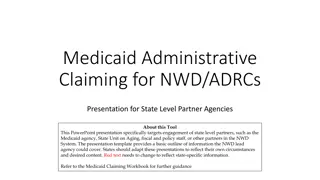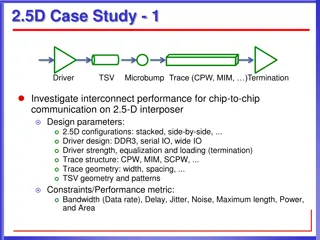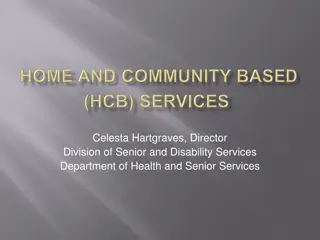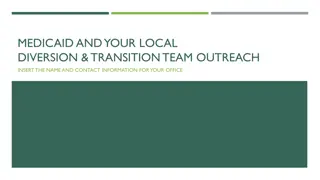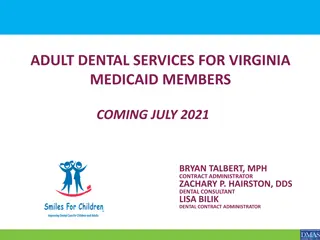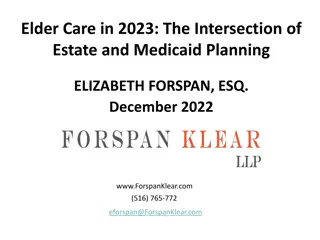and the Role of Medicaid and CHIP
Role of Medicaid and CHIP in providing health coverage for Texas women, including coverage trends, Medicaid recipients, eligibility criteria, and populations not covered. Understand the impact on maternal health and access to care.
Download Presentation

Please find below an Image/Link to download the presentation.
The content on the website is provided AS IS for your information and personal use only. It may not be sold, licensed, or shared on other websites without obtaining consent from the author.If you encounter any issues during the download, it is possible that the publisher has removed the file from their server.
You are allowed to download the files provided on this website for personal or commercial use, subject to the condition that they are used lawfully. All files are the property of their respective owners.
The content on the website is provided AS IS for your information and personal use only. It may not be sold, licensed, or shared on other websites without obtaining consent from the author.
E N D
Presentation Transcript
Health Coverage for Texas Women and the Role of Medicaid and CHIP TMA Maternal Health Congress March 24, 2018 Ryan D. Van Ramshorst, MD, Chair Select Committee on Medicaid, CHIP, and the Uninsured
Texas Coverage Trends United States Census (2009-2016). Health Insurance Tables. Retrieved from www.census.gov/topics/health/health-insurance/data/tables.2009.html
Who Is Covered by Texas Medicaid Source: Texas Medicaid and CHIP Monthly Full Benefit Caseload By Risk Group, Jan. 2018
Texas Medicaid Who It Helps *In 2018, federal poverty level is $12,140 for an individual and $20,780 for a family of 3 Source: Texas Medicaid and CHIP in Perspective, 11th edition
Texas Medicaid Who It Helps 4 million Texans 1 in 7 covered by Medicaid Most recipients live below the poverty level (83%) Most recipients are young (78%) Most recipients are female (55%) Medicaid pays for 52 percent of all births Medicaid is the largest source of behavioral health care, providing pregnant women comprehensive substance use disorder and mental health treatment Texas Medicaid and CHIP in Perspective, 11th Edition (2017). 2015 Data. Retrieved from Texas Medicaid and CHIP in Perspective
And Who It Does Not Medicaid is not available to all poor or low-income women: Must have limited income and qualify categorically Pregnant women lose Medicaid 60 days postpartum unless they qualify for Medicaid based on income Populations not covered: Healthy, childless adults (optional under ACA s expansion) Texas parents earning more than $3,800/year Undocumented immigrants, except in an emergency Legal immigrants (although Texas has option for coverage)
Why Medicaid Matters to Low-Income Women Medicaid is key to improving women s health and addressing Texas alarmingly high rate of maternal mortality and morbidity 52% of births in Texas covered by Medicaid 42% of pregnant women on Medicaid are between age 19 and 24 Provides preventive, prenatal, and postpartum care and complements Texas women s preventive health programs Healthy Texas Women and Family Planning Program For uninsured low-income women, Medicaid also provides breast and cervical cancer screening and treatment Sources: HHSC Presentation Report to Senate Finance 2017; Texas Medicaid and CHIP in Perspective 11th edition
CHIP Perinatal State-federal program established by the Texas legislature in 2005 Provides limited benefits to uninsured low-income women who do not qualify for Medicaid because of their income or immigration status Eligibility applies to the unborn child of a pregnant woman To qualify, a pregnant woman must Earn at or below 200% of federal poverty Be a Texas resident
CHIP Perinatal Benefits Up to 20 prenatal visits Prenatal vitamins, prescription drugs, and vaccinations Limited laboratory testing, and diabetic testing and supplies Labor and delivery (professional and hospital services) Two postpartum visits Among services excluded are inpatient and outpatient care unrelated to prenatal care or delivery, such as treatment for asthma and heart disease, and treatment for mental health and substance use disorders Women enrolled in CHIP-P are not auto-enrolled in the Family Planning Program when eligibility ends
Womens Preventive Health Programs Texas operates two state-funded, preventive health care programs to provide preconception and interconception care to low-income, uninsured women: Healthy Texas Women Family Planning Program
Healthy Texas Women State-funded,* limited-benefit program designed to increase uninsured, low-income women s access to preventive health care To qualify, a woman must be: Uninsured, not pregnant, and with an income at or below 200 % of the federal poverty level ($50,200 for a family of 4 in 2018) Age 15 to 44 (minors can participate with parental consent*) A Texas resident and a U.S. citizen or legal immigrant Adult women (18-44) receiving pregnancy-related Medicaid are automatically enrolled in HTW 60 days postpartum to improve postpartum care
Healthy Texas Women Benefits include: Annual well-woman exam Contraceptive counseling, prescriptions and devices, including long- acting reversible contraceptives (LARCs) Breast and cervical cancer screening, including diagnostic services Screening and treatment* for common chronic conditions, including diabetes, hypertension, cholesterol, and postpartum depression Sexually transmitted disease services Immunizations Treatment for chronic conditions limited to primary care settings specialty care not covered
Family Planning Program State funded, limited-benefit program for low-income women (and men), primarily serving women not eligible for HTW because of immigration status To be eligible, must be: 64 and younger Income at or below 250% federal poverty level Texas resident
Family Planning Program Benefits include: Annual well woman exam Contraceptive counseling, prescriptions and devices, including LARCs Screening for common chronic conditions (but not treatment) Sexually-transmitted disease services Breast and cervical cancer screening, including diagnostic services Immunizations Limited prenatal care
Clients Served by Womens Health Programs Family Planning Program WHP/TWH P/HTW Expanded Primary Health Care Women in Need** Slide graciously provided by the Texas Women s Healthcare Coalition Sources: *Texas Health and Human Services, HHS Women s Health Update, April 2017. EPHC numbers represent 60% of all EPHC clients to reflect proportion of EPHC funding designated for core family planning services. HHS data covers 11 months of FY 2016; data has been prorated to reflect a 12-month period. **Frost JJ, et al. "Contraceptive Needs and Services, 2014 Update," New York: Guttmacher Institute, 2016. FY 2016
Barriers to Reproductive Health Care in Texas Roughly 1.8 million Texas women are in need of publicly funded preventive health services.* Slide graciously provided by the Texas Women s Healthcare Coalition Sources: *Frost et al., Contraceptive Needs and Services, 2014 Update, New York: Guttmacher Institute; 2016 Texas Population Research Project, Barriers to Family Planning Access in Texas: Evidence from a Statewide Representative Survey, May 2015 .
Medicaid Matters to Women and Families Texas Medicaid health plans and commercial PPOs perform comparably on key maternal access to care and quality measures In states that improved health coverage for low-income patients, large body of research has shown that: Rate of uninsured and uncompensated care decreases Patient access to physician services, prescription drugs, and self- reported health outcomes increases Sources: Texas Medicaid Performance Study 2016, UT School of Public Health on behalf of Methodist Healthcare Ministries, Aug. 2016. Effects of Medicaid Expansion - Updated Findings Sept 2017, Kaiser Family Foundation, Sept 2017
Medicaid Matters to Women and Families Medicaid is key to addressing social determinants of health A recent study in Health Affairs found that Medicaid improves economic well-being of enrollees: Medicaid is among the most effective antipoverty programs Medicaid is particularly important for people of color Medicaid impacts outcomes in addition to health: Decreases financial hardship Improves educational outcomes Increases future tax payments by individuals Sources: Estimating The Effects Of Health Insurance And Other Social Programs On Poverty Under The Affordable Care Act, Health Affairs, Oct 2017; Medicaid & CHIP are Long-Term Investments in Children s Health and Future Success, April 2017.
Medicaid Matters to Women and Families Recent changes to federal regulations encourage initiatives by states and Medicaid MCOs to address social determinants of health by providing nonclinical services that improve health outcomes and well being, such as: Population health measures Nutrition services/food security Domestic violence Peer support services Housing supports Environmental hazards (e.g., mold remediation in homes with children with asthma) Source: Commonwealth Fund, Addressing the Social Determinants of Health Through Medicaid Managed Care, 2017
